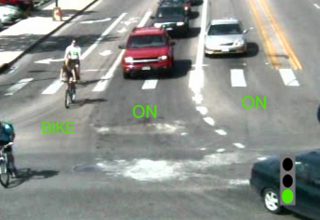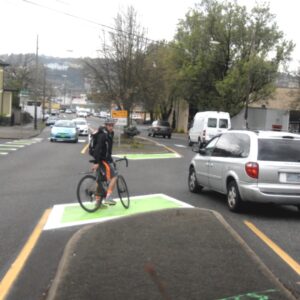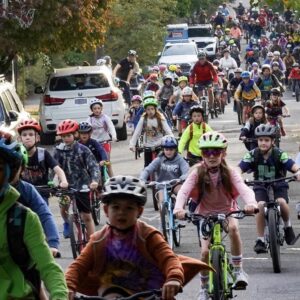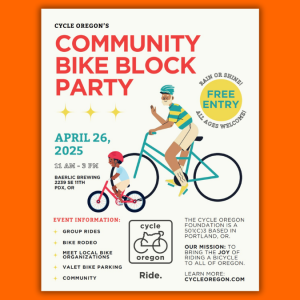
(Image: Econolite)
We’ve been writing for a few months about Portland’s application for $40 million in federal funds that could make it easier to combine services like bike sharing, TriMet, Lyft and so on into a single system of multimodal mobility.
But we haven’t been talking much about another important aspect of Portland’s grant: millions of dollars for connecting vehicles to improve safety.
As city leaders prepare for a personal pitch on Wednesday to U.S. Transportation Secretary Anthony Foxx, the Portland Bureau of Transportation held a “Connected City Expo” Monday to show off many of the companies that could be bringing their knowhow to a Smart City award here in Portland.
It gave us a chance to learn more about the new technologies that could be making streets safer soon, with or without the federal grant for which Portland is one of seven finalists.
Better signal detection
With new equipment, the inductive detector loops the city currently uses to know whether you’re at or approaching a stoplight on your bicycle could become unnecessary.
New local broadcast equipment and sensors “can track you all the way down the street,” said Mike McIntee, director of western sales for traffic-signal firm Econolite Group. That’s in contrast to inductive loops, which “can track you at a certain place and time in the roadway, but not all the way.”
In the short run, this application of Econolite technology would depend on people downloading a mobile app that would presumably help them trigger green lights while on a bike. (It might also help them broadcast their location to nearby connected vehicles.) There’s also a possibility that traffic signals could one day harvest information from passing vehicles about the fact that they have recently passed someone biking or walking, and adjust accordingly.
Jeff Wolf, Econoline’s district sales manager for the Portland area, added that the signals will be able to talk to buses about how many passengers are on board and give them greater green-light priority if they have more than a certain number of people on board.
Advertisement
Better blind-spot alerts
TriMet has been experimenting for years with buses that give audible warnings to people walking that a bus is turning left. Technology from the Israeli company Mobileye, developed as part of the race to build self-driving cars, could be used to alert operators of buses, trucks or trains that someone is in their blind spot.
The previous generation of safety systems was “warning the pedestrian,” said Adrian Pearmine of DKS Associates, a city consultant preparing the Smart Cities application. “This is warning the driver.”
Another benefit of this technology: it’s able to automatically log close calls with people walking or biking. If a particular intersection or corner is causing repeated near misses, TriMet or another agency might be able to identify a street design problem before it kills someone.
Less sudden truck braking
Trucks are heavy. When they get a red light signal while moving quickly, their drivers have to brake fast — or, sometimes, decide to blow a red or yellow light.
Advanced traffic signals that know where a truck is before it reaches them might be able to give that truck a few seconds more of green time to prevent that situation.
There are a lot of disparate parts of the city’s application — it may also loop in the concept of a small self-driving transit vehicle in the Portland International Airport area — but talking to Pearmine today, I had a sense for the first time that all these ideas might be coming together.
“I like our chances,” Pearmine said as I left Monday’s expo.
The city’s full proposal is due next week, and Foxx’s office will choose a winner next month. If Pearmine is right, Portland streets could be safer as a result.
— Michael Andersen, (503) 333-7824 – michael@bikeportland.org
Our work is supported by subscribers. Please become one today.






Thanks for reading.
BikePortland has served this community with independent community journalism since 2005. We rely on subscriptions from readers like you to survive. Your financial support is vital in keeping this valuable resource alive and well.
Please subscribe today to strengthen and expand our work.
I don’t want to discourage experimentation but isnt this all about finding excuses not to deal with the real problem? There are too many cars on the road, and those cars are not adequately separated from vulnerable users. Every technology that doesn’t force us to deal with that is just enabling our addiction and disfunction.
The trend is down for number of cars on the highways. Last year there were 2,000,001 registered MVs in the metro area, this year there are only 2,000,000.
🙂
Cities have been around for thousands of years, yet transportation has only been a problem since the automobile was invented. Probably because cars are inherently inefficient for transporting people. Even self-driving cars are far less efficient than a bus or people riding bikes. No amount of “smart tech” will change this.
Adam,
Pretty broad statement. Any supporting references?
Rome had no traffic problems? London, or Paris, with all those horses?
New York had a problem with dead horse parking.
FACT: There were problems due to poop on the roads before cars. People considered cars a ginormous improvement.
The Great Horse Manure Crisis of 1894:
http://bytesdaily.blogspot.com/2011/07/great-horse-manure-crisis-of-1894.html
Horse poo up to Manhattan’s 3rd floor windows:
http://www.uctc.net/access/30/Access%2030%20-%2002%20-%20Horse%20Power.pdf
🙂
🙂
🙂
That old myth? Pretty sure it was rich people who had the horses, bikes, and cars. Most people walked or maybe caught rides on shared transportation.
Farmers also had horses
You nailed it. No one would be talking about this had the government not committed $4B to the “development and adoption of safe vehicle automation through pilot projects.” On a personal level I would have rather seen $4B go into bike & ped specific safety-enhancement projects.
$4 billion could have also gone into fixing a few of our likely to collapse soon bridges, but this is America we’re talking about. ¯\_(ツ)_/¯
The solution is simple: keep your pants on.
The problem is that the roads aren’t set up to deal with the cars needed. There are not too many cars on the road. There is not enough road for the cars. Self driving cars will help to fix that, by reducing the distance between cars.
Not sure how I feel about it.
One demands everyone use an app with location detection. The other is solving the nearly nonexistent problem of buses hooking cyclists (33 fatalities nationwide in 2013 according to the CDC). And tuckers being able to detect light changes (because the pedestrian countdown timers don’t already do that for you if you’re paying attention).
Just looks like a bunch of city postcard stuff.
I’ve noticed over the last few months that there are quite a few crossing signals that no longer display a count down. We’ve been discussing whether or not it’s some kind of strategy. I’d be interested to know, because it seems like a real step backward.
Personally, I love to see driving tests not just test lawful knowledge, but also teach people how to drive well. Personally, those pedestrian countdown timers are one of the best public tools for safe and efficient navigation the city in a car or on a bicycle. And if they are being replaced that is really too bad.
They can be used to time the lights for less waiting at intersections, and can also be used to start slowing to stop much earlier than relying upon a yellow. I mean if you know you aren’t going to make it just take your foot off the gas and coast to the red. LIkewise, why hustle those last few blocks on a bicycle if you can tell you aren’t going to make the light? Relax, coast and slow down to hit that next green light, saving even just a little momentum makes riding so much easier and pleasant.
We need less reliance on automobiles, not more “smart” tech to enable their use. Even the bike signal detector is suspect: if my phone dies will I no longer be able to get a green?
Fix the real problem, please!
SRSLY. This puts the onus on everyone except drivers to adopt some app in order to get the basic urban functions of traffic signaling and transit reliability. Combining the most obnoxious “alternative transportation” messaging with the most ridiculous technobahn solutions. The streets must work for the people, not the other way around!
Maybe the crosswalk beg button can become an in-app purchase.
But more seriously I thought Econolite was using machine vision based on the image. The app requirement is silly or worse.
Just give everyone a tracking chip. This will also allow more efficient ticketing of people on bikes rolling through stop signs (to “enhance safety”.) But don’t worry drivers: the chips can’t be detected from outside your metal box.
They were definitely talking in the abstract about machine vision of a corridor (which they can already do at a given location) but the app was somehing they envisioned as a half measure, as far as I could tell.
One critical element of “worse”, here, is undercounting or even directly underserving, systematically, groups that are already undercounted in “alternative transportation” spheres and grossly underserved by public infrastructure!
YES
I, too, wonder how this smart world will work for people on foot – especially those who don’t (read: can’t afford) the latest smart phones with smart apps. Thinking more along the lines of what we currently use – namely in-road detection loops – bikes, buses, cars, and trucks all have one thing in common that shoes don’t: metal.
This might be the future we’re talking about, but if we’re not building equity needs into it now that overcomes the very real problems that people who walk face, it’s not going to magically appear.
most shoes have metal in them… enough to set off metal detectors… I’ve been through too many metal detectors…
Sad to see they are leaving driver Telematics out of the proposal. Its already a proven and tested technology for improving driver behaviour. A lot of their proposed and misguided systems are being developed to mitigate the impact of the quickly emerging infotainment industry. People pushing infotainment systems are worried data will show their systems will result in increasing collosions rates, so they want to put in backup systems to allow them to be able to stare at their dashboard most of the time. Telematics anlysis is a way to determine and reward true safe driving, not patch it with backup systems which will only work part of the time.
No thanks. I should not be expected to keep an electronic beacon active on my person to have full access to our public streets. Dystopian future, here we come!
Will a good strobe light make the signals think an ambulance is coming with the traffic lights we have today? Aim it up toward the signal and see if it makes the light change.
If it works, don’t tell the cops.
Short answer: no.
Longer answer: The emergency vehicle signal preemption used in Portland is infrared based. The flashing pattern from the vehicle emitters use a specific encoding pattern that can be configured for 999 different vehicle IDs and 10 different vehicle classes (e.g. bus or fire truck). The signal’s receiver will ignore your strobe unless it happens to use the correct wavelength, with the proper encoding pattern, and has a valid configuration.
It may work. However, it’s a year in jail if you are discovered.
I knew of a few 20 years ago when I drove a taxi. The old Broadway bridge was the easiest of them to set off. The ones I knew of have all been replaced.
And yes the charges if caught were something along the lines of impersonating an officer.
If you want to fiddle with your light go ahead. I’m sure it will pass the time until the light changes just as effectively as kissing your sweetie.
Here’s one idea how Portland’s “Smart City” proposal could improve biking and transportation.
http://www.hayden-island.com/self-driving-car-proposal/
I attended a good hour-long lecture by a promoter of driverless car technology, at a North Carolina convention of city planners and engineers here in Greensboro. The promoter gave a very brief history of the technology, most of which is 30-40 years old, but which has only recently become small enough, and more importantly, cheap enough, to become available for small cars at a commercial level. Currently, only luxury cars like Lexus and Audi are offering the technology, but within 5-6 years, even low-end models will have the technology. He was predicting that by 2025 or so, 90% of cars and other motor vehicles on the road will be driverless-capable. Naturally, he was advocating for driverless-only express lanes on all roads, much like HOV lanes. When asked, he was less clear on how the technology would affect congestion, and was completely uncertain how it would interact with bicyclists and pedestrians.
unless the insurance economics pencil out/push the conversion, it typically takes 20 years for significant turnover of vehicles.
VTPI’s take:
http://www.vtpi.org/avip.pdf
If cars are available without the technology they will be cheaper and many people will prefer to drive themselves rather than depend on flaky computer technology. Once the technology is available, it will take at least 10 years to be proven reliable enough to convince many people to use it.
My wife and I, having just about busted our budget on a new car for her use, were marveling at how much we spent on a relatively recent model car while watching ads for the same type of car that had “blind spot warnings”, “collision avoidance braking”, “rear-view cameras”, and other advanced safety features—for a price. A price that was outside our capacity. Now this safety proposal for an app that one must download onto a smart phone requires a smartphone and data plan, and someplace to recharge batteries frequently (I can’t imagine a “local broadcast” feature is easy on the batteries).
I guess when it comes to safety, you get what you pay for; if you can’t afford it, tough noogies.
That was always my main argument against people who give their young inexperienced drivers full-size body-on-frame SUV’s, because they expect them to crash and want them to be “safe”
What about the people they’re crashing into?
We’ll be back to castles and shiny suits of armor in no time.
Kids are a great excuse for all manners of selfishness.
All these electronic gadgets for cars are like putting a bell on the cat that you let roam around outside so it can’t sneak up and kill all the birds. If you have to do this it means the cat doesn’t belong outside with the birds. Perhaps if you have to do this to make cars safe they don’t belong on the streets with the people.
Perhaps of some significance – you be the judge, in my neighborhood (mid SE) that cat bell to save the birds is a dinner bell for the coyotes.
I am pretty suspicious of the enhanced signals. The latest signals (and ll of the trumpeting about Portland’s superstar signal programmer) seems to be a bit of a wash for peds and bikes. Granted, the signals now can detect people and bikes better, and they COULD prioritize them. In reality, we get beg buttons and blue lights that tell us to be patient while we wait for the endless cars to stream through. I think dumber signals that are carefully timed to control traffic speeds and give plenty of walk time with each light would be a better use of money: more, simpler lights, longer red times.
Can you elaborate on how you think longer red times would affect throughput or safety? I’m genuinely curious.
Longer green and yellow times, on the other hand, allow cyclists to cross intersections safely. In California we’re permeated with loop-signaled crossings that detect the lack of cars and quickly (as fast as 3 seconds) get from yellow to opposing green. On multi-lane roads this can cause even a faster cyclist to be caught mid-crossing, especially when starting from a dead stop inline or lagging the last car turning left, for instance.
I would really recommend reading the proposal and thinking about USDOTs intentions. The goal of this 40 million dollar carrot on a stick is to get people talking about where and how computers can help improve traversing the built environment, and then implement small test beds of these technologies to see what works for all cities. The proposal would not win if it were too heavily focused on bicycling because bicycles don’t present much opportunity for computerization and in most cities they represent less than 5% of the commuting public.
https://www.transportation.gov/smartcity/visionstatements/portland
Equity issues have been thought about in the proposal and money is set aside for free cell plans, text message based subsystems as well as development of the eastern part of the Powell Division corridor and North Columbia Boulevard.
Specific things that will help cyclists and pedestrians include, a mesh net of air quality sensors that can quantify the risks associated with pollution and subsequently be used to justify the monetary impact of improved health outcomes associated with active transportation projects. Google’s Sidewalk Labs data will create a clear picture of how different modes shop and commute with highly precise origin and destination data that will show that cyclists are much more likely to stop in for a quick trip and subsequently make more trips to local stores. This will hopefully reduce opposition to future projects that remove commercial parking. Like LA’s application I fully expect the application to allow you to optimize for reducing CO2 output as well as track yours throughout the year. As for the signal side of things, DSRC radios will allow for disabled individuals to access the phasing information and know when its safe to walk without the use of expensive APS upgrades.
You should really think about how distributed ownership of fleets of vehicles have the potential to greatly reduce VMT and how those fleets are being created to reduce the near 30,000 deaths caused by the use of automobiles each year. The future will be coming regardless, its up to us to shape it to reduce vehicle miles, become safer and more eco-friendly.
See this TED talk for more information, http://bit.ly/27zwcNo
It never ceases to amaze me how, in America, it is possible for a car to make a turn on a green light across a pedestrian signal that shows “Walk”. In most countries cars have a red light when pedestrians can cross at a pedestrian signal.
Red, green—doesn’t matter here as drivers feel entitled to make rights on red as well.
Actually, it amazes me that in America cars can turn across a pedestrian walk signal on a red signal. I’ve been to many countries (typing from Japan currently) and can think of several allowing cars to turn left across pedestrians (yielding to them, as well as drivers going straight) on a green, but few that allow any turn on a red.